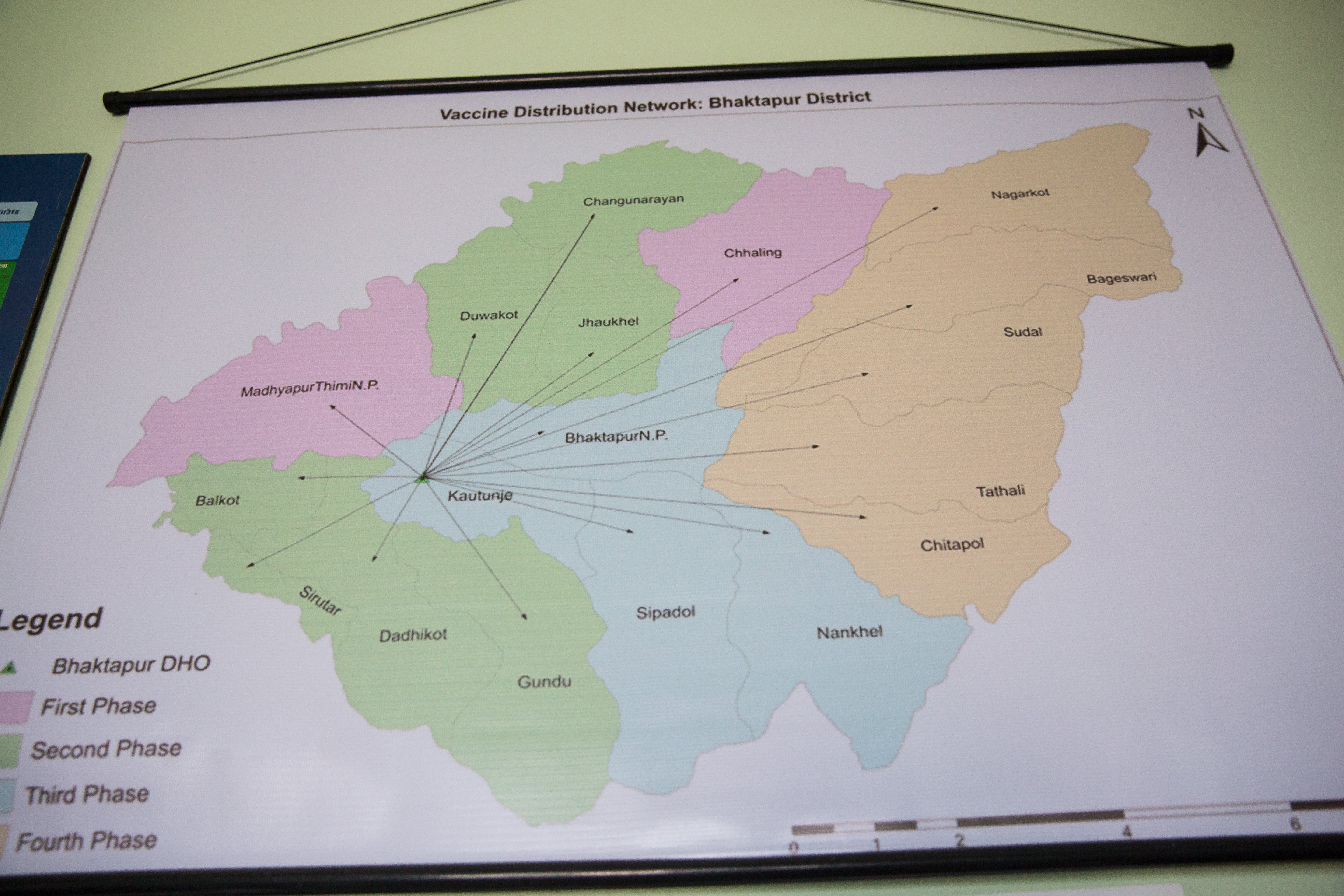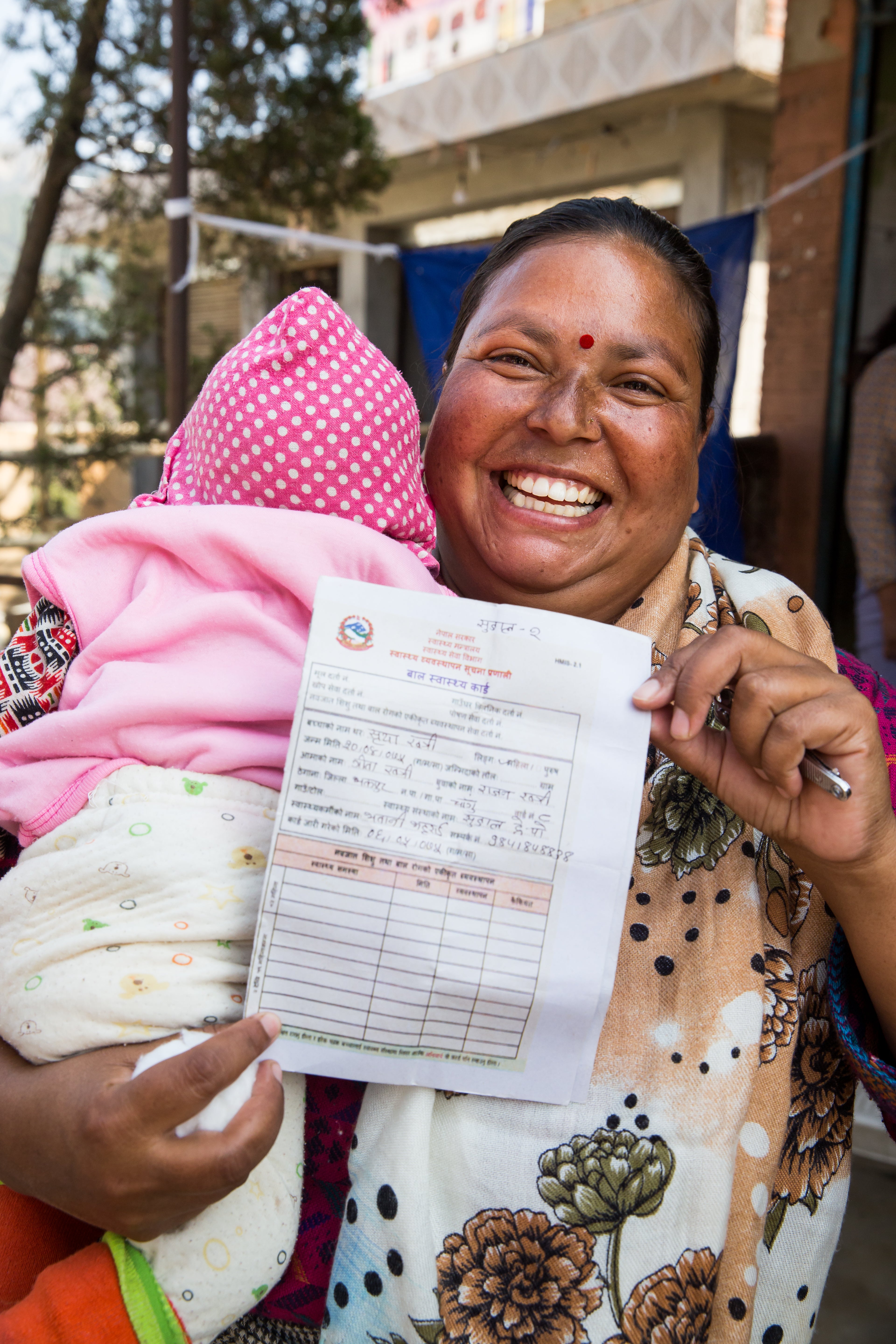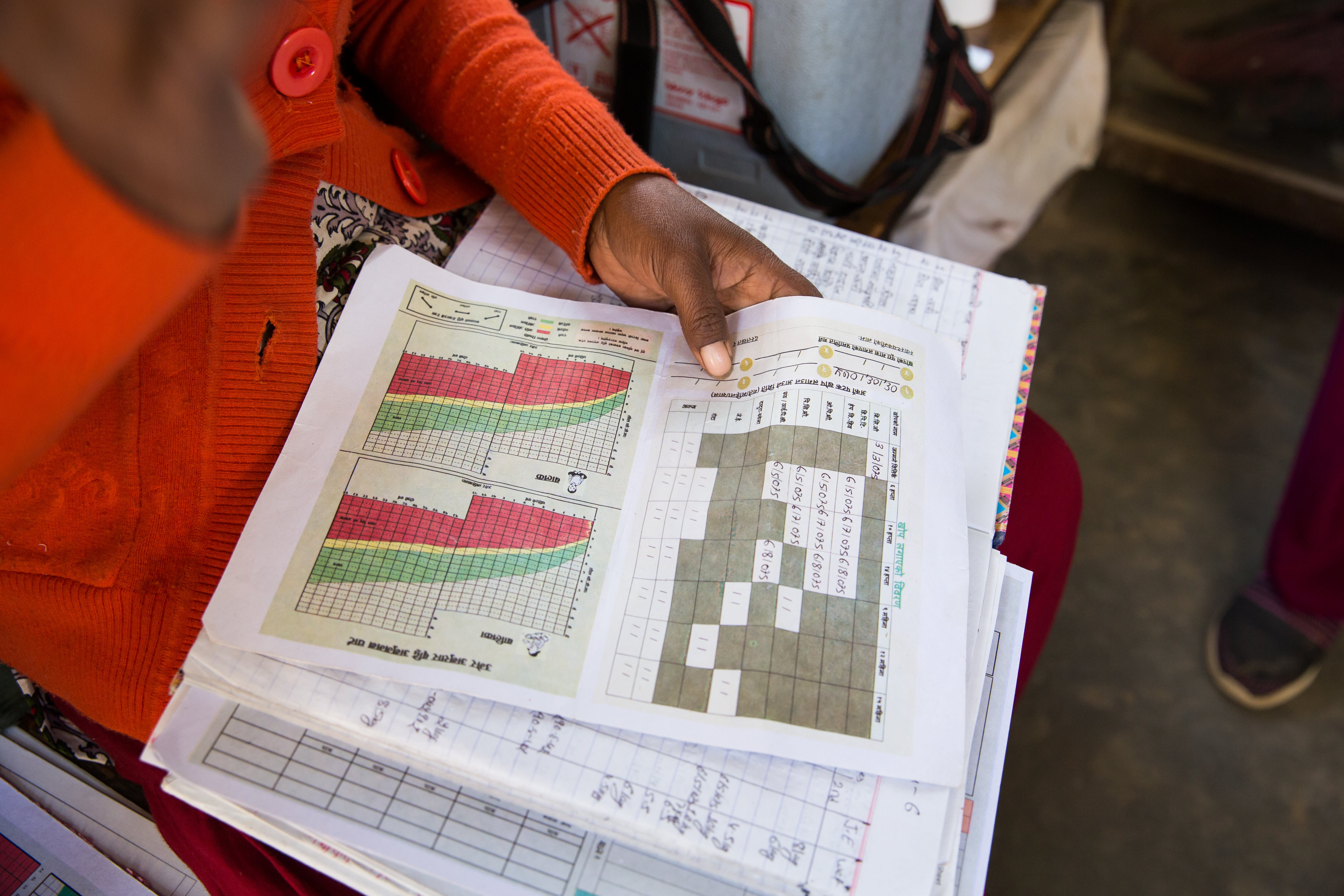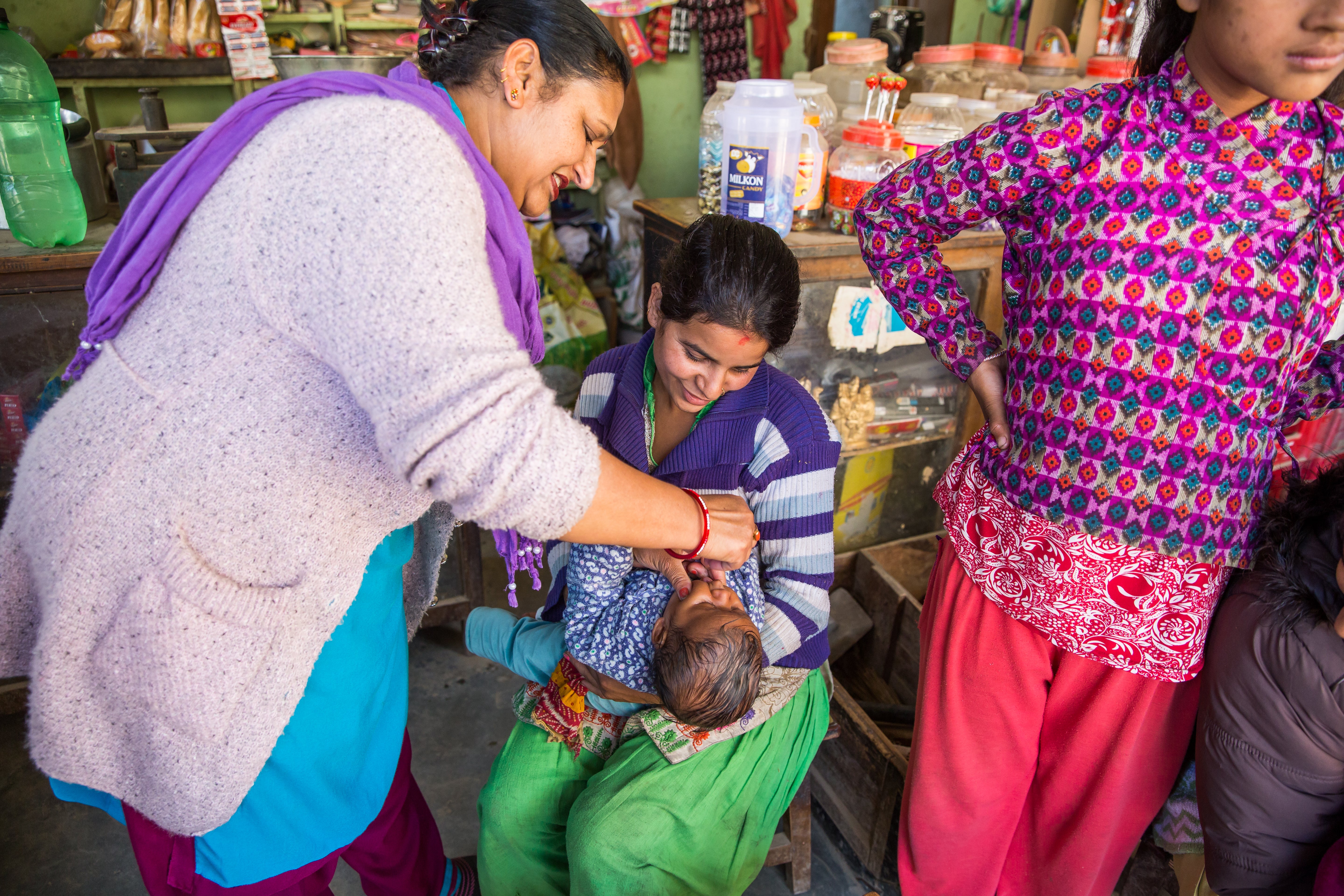Fostered a strong partnership between the health system, local communities, NGOs, and multilateral organizations—and aligned priorities to improve vaccination coverage.
Codified health care as a human right in the constitution, backed with consistent and reliable service provision.
Adopted a system-wide perspective on the strengthening of health services.
Developed a strong and highly empowered female community health volunteer workforce to spearhead vaccination education and outreach in communities.
Fostered a strong partnership between the health system, local communities, NGOs, and multilateral organizations—and aligned priorities to improve vaccination coverage.
Nepal’s ability to sustain a strong sense of partnership contributed to the success of the immunization program during the study period (2006–2016). The national government—and in particular, the Ministry of Health and Population (MoHP)—helped build this spirit of partnership through transparency on decision making and vaccine effectiveness, consistent and reliable service delivery, open communication of government policies to communities, and shared cultural values of altruism and collective responsibility.
Health is everybody’s responsibility—it is incomplete even without support of just one small community. What I think is that until there is a healthy person, a healthy community, and a healthy family, there is no healthy nation.
Community Leader and District Health Officer
Nepal has received considerable technical and financial support from external organizations such as the World Health Organization (WHO), the United Nations Children’s Fund (UNICEF), and Gavi, the Vaccine Alliance. This support is reflected in the nation’s policymaking environment, through direct collaborations as well as the consideration of international guidelines.
However, the Nepali government and MoHP, guided by the national constitution, has remained at the center of the decision-making process. Informants described the ministry’s leadership as essential to the sustainability of the immunization program and to the nation’s ability to adapt service delivery to new challenges. Through it all, the government has showed a consistent commitment to ensuring that all citizens have access to basic health services, which is reflected both in the constitution and in national policies.
Since 2008, the MoHP has implemented various policies and programs to provide essential maternal, neonatal, and child health care services, including vaccinations, to all Nepali citizens at no cost.
More information on the government’s commitment to health care and partnerships is outlined in the next section.
Codified health care as a human right in the constitution, backed with consistent and reliable service provision.
Even before the approval of the nation’s new constitution in 2015, access to health care had been established as a right in Nepal. On this subject, the nation’s decision making and policy environment was grounded in declarations made by multiple countries in South Asia—namely the Alma Ata Declaration in 1978 and the Kathmandu Declaration in 2010., Both of these protocols focused on health as a human right and the central importance of primary health care services, including vaccinations.
During the Nepali civil war, the country continued to prioritize health and access to care. A 2010 analysis of health outcomes during and after the civil war found that contrary to typical health trends in conflict settings, Nepal had made progress on most health indicators during the conflict period, since both sides saw health care delivery as a priority.
In 2007, an interim constitution highlighted health as a right for Nepali citizens to improve the overall health of the nation. The 2015 constitution, promulgated under the newly established government, states that “[E]very citizen shall have the right to free basic health services from the State, and no one shall be deprived of emergency health services.”
Getting a vaccination is a fundamental right and it’s written in the [laws]. The constitution has also included this [law]. If there is any error, such as by a vaccinator, a program error, or if something happened to child, then an investigation is done, and the government has to pay for the loss.
Pharmacy Officer, Health Service Division of the Ministry of Health and Population
This emphasis on health as a fundamental right, a notion supported by national health policies, guided efforts by the government and external partners to improve the delivery of health services, including vaccine coverage. Several of the officials interviewed mentioned that Nepal’s recognition of vaccination as a human right supported the prioritization of vaccines in policy development, motivated community workers, and generated community demand.
Interviewees mentioned that the new constitution was at the center of the government’s decision making in how they adapted and executed policy. The 2016 Immunization Act and 2018 Public Health Service Act further specified that every citizen has the right to free basic health services, including vaccination.
The interviewees also mentioned that health policies at the national level have promoted a rights-based system of health all the way down to the community level, in the form of generally reliable provision of services, as well as the continuous public outreach led by community workers and volunteers. These local efforts have been instrumental to carrying out the national mandate for universal child vaccination. The codification of health as a right in Nepal’s 2015 constitution acted as a foundation for improvements in vaccination coverage. They noted that access to health services, including vaccines, increased over time in Nepal due to government initiatives for decreasing the distance between health posts and adding immunization-specific buildings for vaccination clinics and immunization outreach. Immunization sessions are conducted on the same day, time, and location each month, and are highly publicized throughout the community—which considerably improved access for nomadic individuals and those in harder-to-reach locations. The standardization of immunization clinics provided individuals with structured and reliable access to services, which were commonly mentioned by key informants as drivers for demand.
Adopted a system-wide perspective on the strengthening of health services
Beginning in the late 1980s, the government recognized that reducing Nepal’s high child mortality rates needed to be a national priority. This led to a sustained commitment to strengthening the overall health system infrastructure of Nepal.
Key informants noted that the Nepali government’s commitment to expand health infrastructure and offer free health services to all citizens contributed significantly to the success of the vaccination program. These policies also reflected the nation’s commitment to the strengthening of the health system as a whole, rather than to a piecemeal approach to policies and planning.
The emphasis on health systems strengthening has deeply informed Nepal’s push for improved vaccination coverage, according to key informants. As access to health posts and vaccination centers increased, so did efforts to reach underserved populations, even in the most remote communities.,, According to the 2021–2022 annual report from the Department of Health Services in Nepal, there were 16,950 Expanded Programme on Immunization (EPI) clinics providing immunization services, staffed by 50,229 female community health volunteers (FCHVs). This marks an increase from 16,428 EPI clinics in 2018–2019 and 16,260 EPI clinics in 2010–2011., According to one interviewee, it is now the goal to have three to five immunization centers and outreach clinics for each municipality, constructed and monitored by the national government.
The average time, measured in minutes, to get to the nearest facility by motor vehicle was 11 minutes for all provinces in 2022 (Figure 8). Karnali Pradesh was an outlier, with an average time of 29 minutes. The average time to the nearest facility by foot across all provinces in 2022 was 29 minutes. In Sudurpashchim Pradesh, the average time by foot was higher at 39 minutes, and in Karnali Pradesh it was 55 minutes. The terrain in Karnali and Sudurpashchim Pradesh consists of mostly hills and mountains, which may contribute to the longer travel times compared with other provinces (Figure 8).
Figure 8: Travel time to health facilities with vaccination services

Additional health personnel, including vaccinators, were employed to monitor and contact children who were missing vaccines. FCHVs were able to increase their efforts to reach children in remote areas. Government investments in the Nepali health system maintained the quality of vaccine services across the population and helped ensure equitable access.
The roots of this systemic approach can be traced to 1991, when the National Health Policy was passed with the aim of increasing primary health care services for rural and disadvantaged populations. As a result of this policy, health posts with birthing facilities were established in every village development committee area, and FCHVs were mobilized to promote and deliver basic health services, including some vaccination services. Additionally, FCHVs who were part of mothers’ groups provided information on immunization services.
Mothers’ groups consist of 10 to 15 mothers who meet regularly to discuss issues such as immunization, family planning, literacy, and finances. With FCHVs participating, the meetings provide a forum for discussing vaccination rights and the quality of immunization services.
The 1991 National Health Policy was considered by many key informants at the national level as a turning point for immunization coverage in Nepal. This policy was not specific to vaccination delivery but instead worked to strengthen overall health infrastructure, outreach channels, and coordination across programs including immunization services.
The National Health Policy was mentioned consistently as a catalytic policy decision point by officials who were interviewed, which highlights the importance of overall health systems strengthening in the improvement of vaccination coverage. The success and implications of this policy speak to the important tie between vaccination programming and improvement in broader primary health care.
In the beginning, access to the vaccination program was very weak. Probably in the last 20 years—and to be specific, I think in the 90s, after the National Health Policy 2048 [1991] came—the immunization program was taken on as priority program, and then the development started. It was developed in 4-5 years, and it was not affected at the time of conflict. And recently too there was conflict in the country, but this program was not affected. …
Official, Policy Planning Division, Ministry of Health and Population
More recent policies and programs specific to vaccination delivery continued to focus on improved and accessible infrastructure, which remained an essential tool for reaching all Nepali children.
Even disease outbreaks—while hardly welcome developments—are seen as opportunities for systems strengthening, worker trainings, and educational opportunities. Catch-up vaccination activities are conducted as part of the outbreak response, resulting in improvements to routine immunization coverage.

In 2012, the Full Immunization Program (FIP) was initiated, further highlighting the government’s commitment to Reaching Every Child (REC) with vaccinations. To be fully immunized, a district must show that every child under 15 months of age has received all of their required vaccinations. Implementers are given incentives to reach full immunization, and municipalities are given additional resources to celebrate the accomplishment with community members. Increased public awareness and demand for vaccines support the success of the program, which in turn promotes urgency and action among all key players.
Fully immunized provinces, districts, and municipalities are celebrated by the national government. Children who are fully vaccinated receive an official vaccination card from their health post for documentation. For more information on increasing demand for vaccines, see
To our knowledge, no other country has implemented such a program, making it unique to Nepal’s vaccination efforts. Key informants reported that the FIP was modeled on community-led total sanitation strategies to decrease open defecation. The process to reduce open defecation is similar—once all households in a community or district meet the criteria for access to latrines, absence of open defecation, and other hygiene practices, the area is declared as “open defecation free.” This strategy was effectively implemented in Nepal, and although there are concerns about setbacks over time, the urgency and motivation from the sanitation campaign led to the declaration of Nepal as open defecation free across the country.,
Similar to the strategy, for the FIP, once a municipality states that all people in the area are fully immunized, this claim is checked by the district-level government. Data used to determine fully immunized status includes a review of immunization cards and FCHV reports that document the immunization of all children in the area. An entire district is celebrated as fully immunized after all municipalities have been verified and checked by the regional government, and then it may be recognized nationally for its success. As of 2021, 61 out of 77 districts were declared fully immunized.,

According to key informants, the FIP strategy worked well to motivate service providers, community workers, volunteers, and parents; however, some interviewees noted that monitoring efforts stop after an area achieves full immunization. Although routine immunization activities and campaigns continue, there are currently no strategies in place to sustain full immunization in municipalities that have been certified, leading to concerns about whether the added benefits of the FIP will be sustained in areas declared as fully immunized.
Developed a strong and highly empowered female community health volunteer workforce to spearhead vaccination education and outreach.
Female community health volunteers (FCHVs) are frontline community health workers in Nepal. The government initiated the FCHV program in 1988 in 27 districts, and expanded it to all 75 districts in 1992. Initially, FCHVs were assigned to promote and distribute family planning materials and contraceptives; however, their roles have expanded beyond family planning to include the implementation of many community-based maternal and child health programs. FCHVs are also explored in other Exemplars in Global Health research about neonatal and maternal mortality reduction, and under-five mortality reduction in Nepal.
FCHVs are selected by the members of health mothers’ groups who are actively involved in local health activities., FCHVs are required to be ages 25 to 45 years and permanent residents of the communities they serve. Women who are married, literate, or from marginalized groups are prioritized for selection. FCHVs usually work part time, averaging approximately seven hours per week, which can vary depending on the location where they serve.
FCHVs are expected to attend an 18-day training course before beginning their duties. At this training, FCHVs are given materials such as a manual, behavior change communication resources, and first aid supplies to complete their duties. Furthermore, FCHVs should receive a refresher training every year. While personnel at the national level described these refresher trainings as highly important, many FCHVs in the study reported that they often did not occur, especially since the decentralization of the government.
As mentioned earlier, the role of FCHVs evolved, with a pivotal shift happening in 1993 with the advent of Nepal’s highly successful national vitamin A program, which relied on FCHVs for service delivery. As a result of the vitamin A program, additional funding was provided for the FCHV program and their responsibilities increased. Over the last three decades, following four revisions of the FCHV strategy, their functions have expanded to include additional maternal and child health services, including support of the national immunization program. Importantly, their role as a critical bridge between the health system and the community has been codified and affirmed.
This evolution of the FCHV program and role is reflected in the number of FCHVs in Nepal. The National Health Policy in 1991 stated that each community should have one FCHV. By 1995, FCHVs were established in all 75 districts in Nepal. In 2003, the MoHP announced target ratios of one FCHV per 1,000 population in the Terai, one per 350 in the hills, and one per 250 in mountain districts. As a result of this target, in 2022, there were over 52,000 FCHVs throughout the country.
While FCHVs’ responsibilities have historically been related to health service delivery, recent changes have shifted their portfolio to include a higher proportion of public education work, in which the volunteers build community awareness of available health services. FCHVs also played a key role in supporting communities following the 2015 earthquake. The MoHP continues to rely on the FCHVs’ connection to their communities to build awareness and education as well as deliver frontline health services.
We have acknowledgment [from community members] and pride in this program [FCHV program]. Therefore, we are happy. In every ward, people search for us. They [pregnant women and mothers] give respect to us.
Female Community Health Volunteer, Madhesh Pradesh
With the National Health Policy of 1991, FCHVs became responsible for providing support to the national immunization program. Some of their responsibilities include identifying mothers who do not access vaccination services, visiting households to address misinformation, and addressing the concerns of caregivers in their community. Furthermore, FCHVs deliver door-to-door reminders of vaccination days, telling parents the specific vaccinations needed for each child in the household.
FCHVs also collect and record data on the target population of children under the age of two years. Because they are integrated in their communities, FCHVs typically have more recent information on births that have occurred outside health facilities. In conducting door-to-door follow-up of unvaccinated children, FCHVs can identify children who have not been fully immunized and report this data to the health facilities. They also follow up through in-person meetings, phone calls, and SMS messaging, and they encourage mothers to bring their children for immunizations the following month.,
While the FCHV program has been instrumental to many community health programs in Nepal, the program has had challenges. From the initiation of the FCHV program in 1988, some FCHVs have reported that they are underappreciated and deserve increased compensation and incentives that are commensurate with the significance of their role in the national health system.

In response to these concerns, the national government instituted an FCHV fund to provide cash support to each village’s development committee. Additionally, since 2010, the government has instituted an FCHV appreciation day, provided a letter of appreciation from the government, created a distinguished identifying logo, and developed a unique identity card for FCHVs to show distinction in the community. Among other incentives, FCHVs receive free health care from health facilities, rewards for high performance, and daily allowances for additional training, especially those held by NGOs. However, despite these increased incentives, FCHVs still frequently report that they are undervalued and overburdened by the government, and in some cases, by the communities they serve. In 2014, a sample of FCHVs reported that, “Compared to my past, my duties have significantly increased.”,
As volunteers, FCHVs receive the same incentives regardless of their experience and length of tenure. There have been calls for higher levels of compensation, and partners at the national level have expressed concern about the low pay offered to FCHVs, especially given the national push for higher rates of immunization. Despite these problems, national officials interviewed for this study said there has been increased competition for FCHV positions in recent years.
Another element of community health that FCHVs support is health mothers’ groups—community groups that bring together women to discuss and promote healthy habits. Health mothers’ groups consist of “all interested mothers of reproductive age” and are formed with the involvement of the community, local health institutions, and local governments. The fourth national FCHV strategy, published in 2010, emphasizes selecting mothers from certain demographics such as those from marginalized backgrounds, to promote equity and increase these women’s standing within communities. Health mothers’ groups are active across the country and were mentioned favorably by interviewees in all study districts.

An integral component of FCHVs’ responsibilities is to build awareness and educate health mothers’ groups HMGs on specific health topics. HMGs organize informational meetings for women of reproductive age to discuss various health topics of their choosing, including immunizations. FCHVs conduct these meetings once a month, often on the same day as the immunization or outreach clinic.
Key attributes of the FCHV profile

These meetings provide an opportunity for women of reproductive age to learn about topics such as family planning, pregnancy, and neonatal care, including immunizations. Women in HMGs are tasked with sharing information from the meetings with other mothers in the community. HMG meetings occur in 92-99% of communities in every province in Nepal, and the 2019 DOHS Annual Report stated that there is a consistent increase in HMGs in every district.
